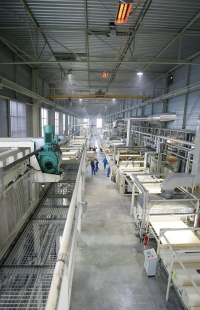by By Craig Zurawski — When it comes to leading the way in the movement to green buildings, people often assume that a building’s design and the right architect or general contractor are the most important factors in getting the job done. Although it would be difficult to argue the contrary, it is fair to say that building product manufacturers also play a critical role in creating high performance green buildings and fostering positive financial, environmental and social outcomes for a company that decides to go green through its facilities.
The development of innovative, sustainable products and services for the built environment is a very important role for manufacturers. However, many leading manufacturers and smaller entrepreneurial companies also see it as their responsibility to educate the green building market and to partner with organizations that promote sustainability to initiate change in the marketplace.
Delivering green products
The role of a product manufacturer in the green market is to deliver innovative products that are environmentally responsible and do not compromise performance. According to Bill Gregory, director of sustainability for Milliken & Company, an international carbon negative chemical and textile manufacturer, it is the manufacturer’s responsibility to develop more sustainable products using accepted standards to evaluate each product’s total environmental impact.
 |
| The development of innovative, sustainable products and services for the built environment is a very important role, if not obvious, for manufacturers; however, those who are industry leaders, also see it as their responsibility to initiate change in the marketplace. |
Gregory explains that sustainable practices are integral to decision making. “At Milliken, we use lifecycle assessments [LCAs] to understand the total environmental impact of our products and processes. We bring innovative carpet solutions to the marketplace based on a holistic approach to green products versus concentrating on a single attribute like recycled content.”
Milliken takes into account the full product cycle-sourcing of raw materials, production, installation, maintenance and end of useful life options. A lifecycle assessment provides an understanding of the full impact of a manufacturer’s products and processes on the Earth known as an environmental footprint.
Kohler Co., a leading plumbing and fixture manufacturer, also looks at all aspects of the design and manufacturing process to reduce the environmental footprint of its products.
“We have to provide products that support the overall mission of green building, which is to reduce the environmental impact of new and existing buildings,” said Rob Zimmerman, senior staff engineer. “In the case of Kohler’s water-efficient plumbing products, we strive to offer the widest choice of products, so that designers and architects don’t have to sacrifice style to capture the products’ environmental benefits.”
Although Forbo Flooring, a flooring manufacturer, offers a product that is made out of natural materials-mainly linseed oil-and already has a low impact on the environment, the company takes responsibility to work to continuously improve its products.
“We are continually setting goals for improving because there’s no perfect environmentally friendly product out there,” said Tim Cole, director of environmental initiatives and product development. “Even when product manufacturers have a great environmental story to tell, the leaders and innovators continue to set goals to improve.”
Since the surge in interest in sustainability, Forbo has added an extra set of environmental criteria that its products must meet in their development process before they proceed to the next step in becoming new products.
Another leading company in the green building movement, Johnson Controls, Inc., a major provider of energy solutions, has added sustainability to one of its six basic core strategies for the company.
“Everything we do within our building efficiencies division is about delivering high performance green buildings,” said Paul von Paumgartten, director of energy and environmental affairs.
All companies that want to be on that leading edge of the sustainability movement need to be able to see where the trends are going and be ahead of customers’ needs.
 |
| Evaluating the source and composition of raw materials is the beginning of a life cycle assessment for a product. Adding a review of its production, installation, maintenance, and end of useful life options makes up the full product cycle, or environmental footprint, of any product. |
“Part of a manufacturer’s role is having key people in the company that see where the market is going and what the trends are,” said Richard Master, manager of architectural and construction systems of USG Corp., a building materials manufacturer.
Lowering the environmental footprint
While it is a product manufacturer’s responsibility to look at the whole manufacturing process and develop more sustainable products for the green building market, he or she also has a responsibility to lessen the environmental footprint of the facilities he or she operates.
“What good is it to have a very energy efficient product if you’ve already negatively offset the energy savings when you manufactured it?” said Steve McGuire, environmental marketing manager at Philips Lighting, a lighting products manufacturer.
Owens Corning, known mainly for its innovative insulation products, actively participates to transform the market around energy efficiency by making changes to its facilities to decrease their environmental footprint, according to Bob Dehne, architectural services manager, whose corporate headquarters in Toledo, Ohio achieved LEED©-EB (Leadership in Energy and Environmental Design — Existing Buildings) Silver certification.
“We have been working on our own internal lifecycle assessment program to not only develop our products, which is very important, but also to assess our facilities and the suppliers that we work with.”
LEED certification has been a shared goal for many companies. “Any new building or major renovation of a JohnsonDiversey facility, a cleaning products and solutions manufacturer, is undertaken with intentions for earning LEED certification,” said Tom Seitz, director of sustainable facility care. “We see it as our responsibility to help our customers achieve green buildings, too.”
 |
| Sustainability begins at home. Milliken & Company, an international carbon negative chemical and textile manufacturer, certified its Merchandise Mart showroom in Chicago LEED-CI. |
Johnson Controls had the first LEED-EB certified facility-the Brengel building. It is currently renovating its corporate headquarters campus in Wisconsin and will seek LEED Platinum certification.
Sharing sustainable knowledge
From building awareness for the eco-efficiencies of green product solutions and educating building owners on what goes into a sustainable facility to encouraging sustainability among employees, manufacturers say that education is a key component to furthering the green building movement and the market.
It is a product manufacturer’s role to educate the marketplace about what green products are available and the environmental impacts of those products, according to Zimmerman.
“Kohler Co. is an active partner in the EPA’s [U.S. Environmental Protection Agency] WaterSense© labeling program, which is designed to help consumers identify products that use less water while still meeting strict performance standards,” Zimmerman said.
This is an easy way to inform consumers on what products are out there that are environmentally responsible. Companies that have partnerships with respected programs like WaterSense or ENERGY STAR© can make green purchasing decisions easier, because of the third-party acknowledgement that specific standards are being met.
It is important for those people purchasing products that will help deliver a high performance green building to understand what needs to be considered within the product categories and what role these products play in regard to efficiencies, indoor environmental quality and sustainable building materials.
“Often, people are concerned only about a product’s recycled content. However, a more sustainable approach examines the entire lifecycle for a holistic footprint,” said Gregory. “We must continue to educate on what sustainability truly means and how our products contribute to green building.”
 |
In addition to educating the industry, companies are making sure that their own employees are educated on the importance of sustainability.
“We’re doing what we can on the environmental side as far as manufacturing a product, but we are also setting more goals for the facilities we own and work in. In addition, we’re encouraging our employees to not just think about the environment when they’re at work, but to carry what they learn at work into their personal lives,” Cole said.
Partnerships with similar goals
Product manufacturers that are dedicated to sustainability are going further than delivering innovative products and educating the marketplace, they are initiating change in the world. Many product manufacturers partner with organizations and federal agencies whose goals are to promote sustainability in the built environment and educate those in the industry on what they can do to meet their needs without compromising the needs of future generations. Some of those organizations include the U.S. Environmental Protection Agency, the U.S. Department of Energy, the U.S. Green Building Council, the National Association of Home Builders, the American Institute of Architects, the Institute for Market Transformation to Sustainability, the National Association of Energy Service Companies and the Alliance for Sustainable Built Environments.
“If you’re going to be involved in the movement, you need to be involved with the non-profits that are really striving to make a difference,” Cole said.
“In a world where everyone is claiming to be green, how do you display leadership?” von Paumgartten asked. “The organizations that we want to be part of and the other members we participate with are the ones that have a similar environmental ethic as ours.”
According to McGuire, being partnered with these organizations helps product manufacturers educate the marketplace on what really constitutes green products in a building and eliminates some of the confusion about greenwash. These partnerships allow product manufacturers to communicate with each other, share their insights in order to stay ahead of customers’ needs, and deliver the science to support the development of future government regulations.
It is easy to see that the product manufacturers who are truly committed to sustainability are doing more than simply offering green products to meet market demand. They show their dedication to sustainability through reducing their environmental footprint by greening their own facilities, educating the marketplace and their own employees on the importance of sustainability, and partnering with organizations who can facilitate positive change.
The power of the facility manager
Facility managers should have high expectations for their suppliers.
“Facility managers have to realize they have all the power and they need to push product manufacturers,” Cole said. “If they know of one product manufacturer that meets the needs they’ve set, then they should make every manufacturer they deal with do the same thing.”
Facility managers should also insist that their product suppliers are in tune with their own internal sustainability objectives.
“What good is it for me to be sustainable when I’m not checking my suppliers and making sure they’re not using harmful materials or processes?” McGuire asked.
Along the same lines, facility managers should expect a statement from suppliers that defines what makes their products green, Master said. It is important for manufacturers to fulfill the promises they make.
“What really is going to motivate every product manufacturer are customers saying, ‘Sorry, don’t even come into my office unless you can supply me with complete lifecycle analysis for your product,'” Cole said. “That is the driving force that I want to see.”
For high performance green buildings to become the norm, the process to create new or retrofit old facilities needs to be a shared responsibility. Architects, designers, product manufacturers, building owners, government, non-governmental organizations and facility managers need to work together while challenging each other and themselves to achieve the financial, environmental and social benefits of going green. Each entity has an important role to fulfill if the built environment is to be successful in becoming truly sustainable.
About the author

Craig Zurawski is the executive administrator for the Alliance for Sustainable Built Environments, a group of industry leaders whose goal is to inform and educate decision makers at every level that the choices they make in regard to their facilities can be both economically and environmentally sustainable. The Alliance formed in 2003 and its current members include Johnson Controls, Kohler Co, Philips Lighting, Forbo Flooring, Owens Corning, USG Corp. Milliken & Company and JohnsonDiversey.